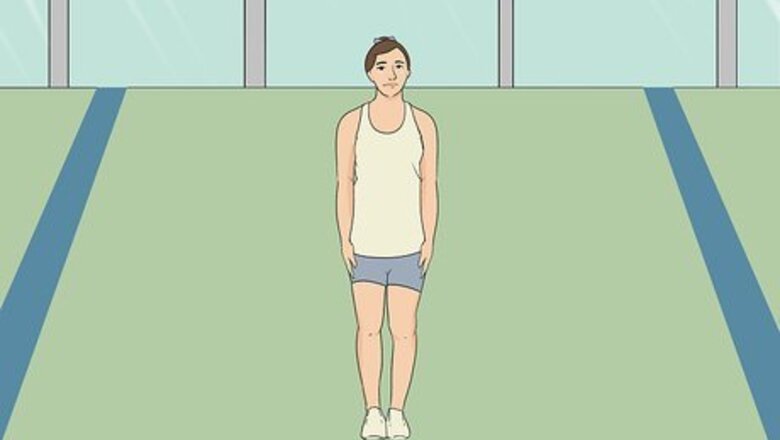
views
Approaching the Jump
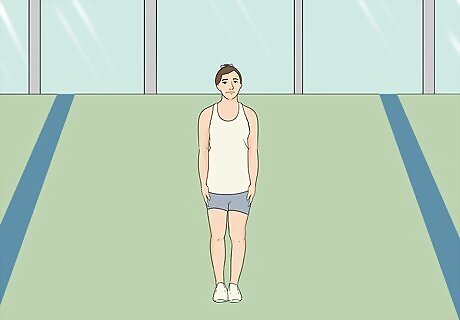
Stand firmly on the ground with your legs together. Stand upright with your chin up, arms long by your sides, and shoulders back in a relaxed, pulled-back position. Your legs and feet should be together in one long line. Face the crowd and don’t forget to smile! Make sure to spread your weight evenly through both feet. When you jump, you’ll push off the balls of your feet, so leaning too far back into your heels during the approach will make it more difficult to launch.
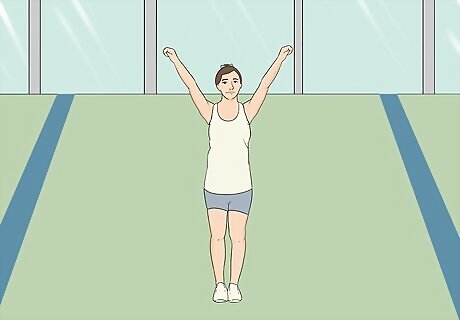
Extend your arms upwards into a high V position. Straighten your arms and swing them upwards to create a V-shape above your head. Make light fists with your hands for a classic cheerleading look. Avoid hunching your shoulders up towards your ears. Continue to lift through your chest when you extend your arms. This will help push your arms slightly back into the proper position and ensure you have a nice, sharp looking form.
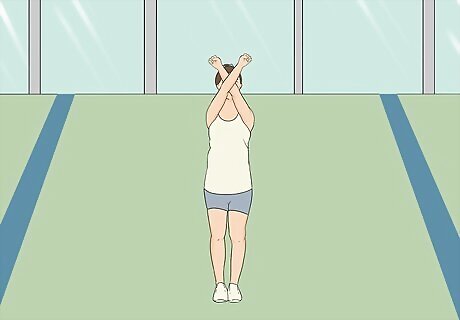
Cross your wrists overhead and bring them down in front of your body. End with your fists on top of your thighs. Make sure to keep your chest, shoulders, and head facing forward. This arm swing helps to build momentum which will help you jump higher off the ground.
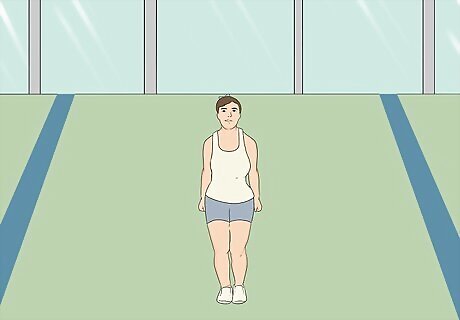
Bend your knees as you bring your arms down. This bend will help give you more power when you jump. Bend your knees just slightly into a light squat rather than a 90 degree angle. Keep your chest lifted and facing forward throughout the motion. To protect your back, keep it as straight as you can. Try tucking your hips slightly to avoid arching into your back.
Executing Different Jumps
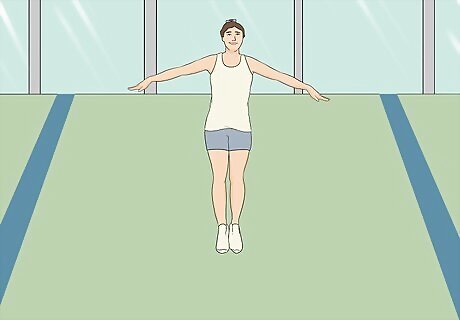
Straighten your legs as you push into the air for a basic pencil jump. Extend your legs and launch yourself off the ground to jump. Keep your legs glued together and your knees straight, pointing your toes in the air. Swing your straight arms into a T-position as you jump. A pencil jump is considered to be the most basic cheerleading jump. It provides a foundation for more complicated moves. Beginners should make sure they’re comfortable with this move before attempting other jumps.
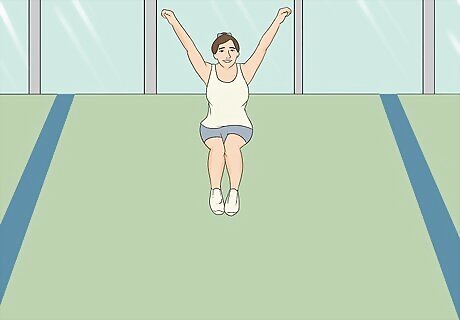
Pull your knees up towards your chest for tuck jump. As you push yourself off of the ground, drive your knees up towards your chest and bring your arms back to a high V position. Keep your toes pointed and your chest facing straight forward rather than curling down towards your knees. It may be helpful for you to practice this jump by standing on one leg and bringing the other knee up towards your chest in a tuck position. Then switch and try the other side. Once your body is used to the motion, try the jump. Do not extend your feet behind you, which can cause you to fall forward.
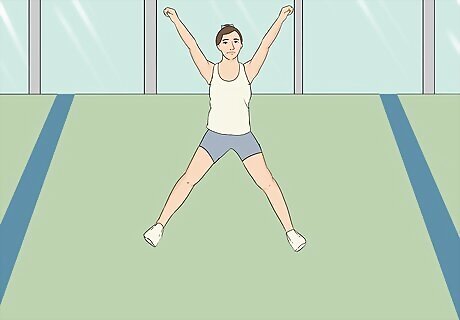
Hit a spread eagle by creating an X position with your limbs. As you launch yourself into the air, extend your arms and legs wide in opposite directions to create an X shape with your body. Keep your toes pointed and all your limbs as straight as possible. Your knees and toes should face forward. Again, it may be helpful to practice this pose on the ground before bringing it to a jump. Stand with your feet further than hip-width distance apart, toes and knees facing forward, and bring your arms into a high V position. Once you feel strong and stable on the ground, try the full jump.
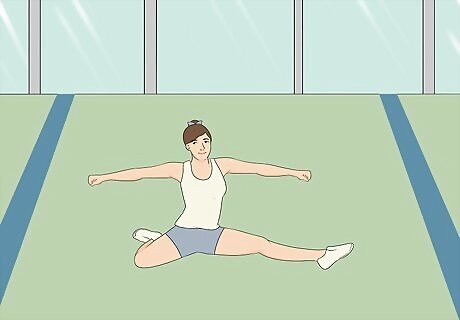
Do a Herkie by extending one leg straight to the side and bending the other behind you. Try to bring your straight leg parallel to the ground, in line with your hip. At the same time, bend your other knee to bring your toe towards your bottom, as if you were trying to kick your butt. Attempt to bring your entire leg parallel to the ground so that your inner thigh faces down, rather than inwards toward your body. Your knee should point forward. This move is also known as a side hurdler. You can either extend both arms into a T-position or punch one directly up towards the sky and place the other on your hip for a more traditional look. If you choose this variation, make sure to extend the arm and leg on the same side of your body. Try mimicking the mid-air position on the ground before attempting it as a jump. Sit on the floor with one leg out straight and bend the other at the knee as if you were attempting to kick your bottom. Try shifting your bent foot out from underneath you so that your inner thigh and knee are resting flat on the ground.
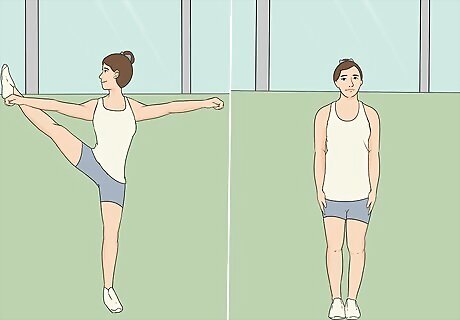
Extend your legs to either side of your body for a toe touch jump. The toe touch is considered to be one of the more famous but challenging cheerleading jumps. To give it a shot, straighten your legs as your feet leave the ground and bring them directly up into a mid-air side split. Roll your hips outward so that your knees point up. As you jump, extend your arms directly out from your shoulders to a T-position. Don’t be discouraged if you’re not actually able to reach your toes when you jump. Despite the name, many cheerleaders never touch their toes in this move. Having flexibility through your hamstrings, lower back, and hips is helpful for a successful toe touch, so stretch those areas regularly to improve your form.
Landing Safely and Gracefully
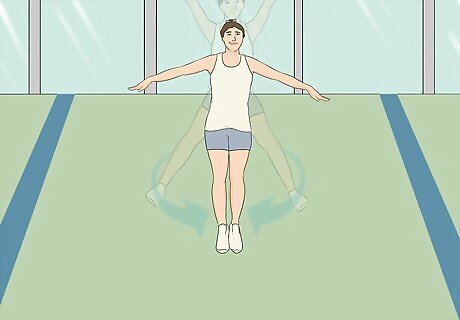
Snap your legs back together if they were separated in the jump. During poses like the spread eagle, Herkie, or toe touch, your legs are separated in the air. As you land, snap your legs back to touch so you hit the ground with feet and knees aligned. If you're just learning a jump, it may take some practice before you're able to fully snap your legs back together in time for the landing. It's okay to land with legs separated as you're learning, but try to keep them hips-width distance or less for a safer and more solid landing.
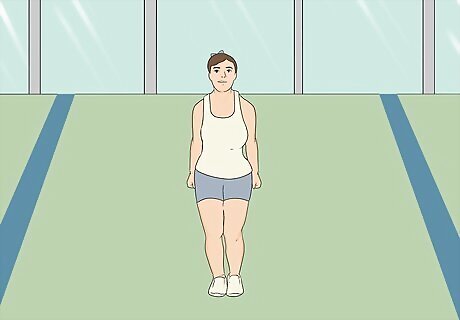
Hit the ground with soft, bent knees. Your feet and legs should be together in one line, with arms extended long by your sides. Face your chest directly forward, rather than letting it sink towards the ground. You should be able to look straight out at the crowd. Land toe-to-heel to protect your knees and back.
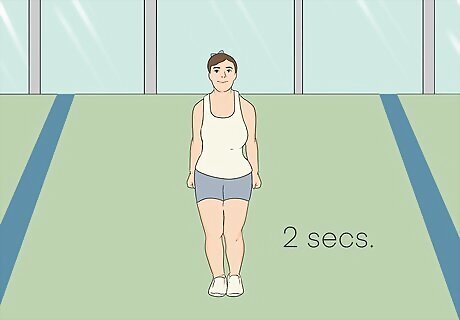
Hold the landing pose for 2 beats to regain balance. Many cheerleading moves are timed to an 8 count beat that helps keep the entire cheer squad in sync. To make sure everyone is balanced and on the same timing after a jump, most coaches will have you hold your landing for 2 counts. Simply keep the same pose you stuck in the landing, with legs together, knees bent, and arms extended long by your sides.
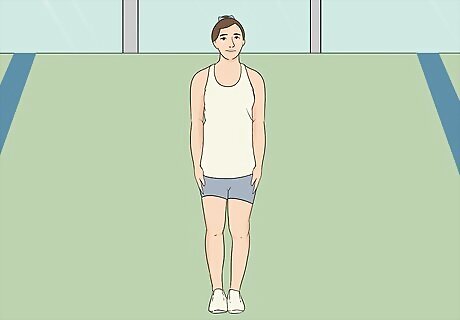
Straighten your legs to return to standing. Extend your knees and stand facing the crowd to finish the move in the same way you started it. Your arms can either be extended long by your sides or placed on your hips. The basic standing pose used to finish a jump is sometimes called a “clean.” For example, as your coach calls out the different parts of a jump, they may finish by saying “land, hold 1, 2, and clean.”



















Comments
0 comment